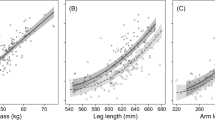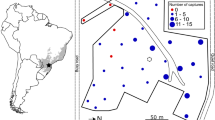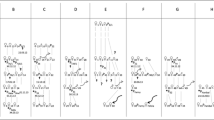Summary
The ideal dominance distribution model predicts that competition between individuals of a species for territories will result in socially dominant individuals acquiring territories in higher quality habitat than their subordinates. Although the dispersion and relative reproductive success of male red-winged blackbirds (Agelaius phoeniceus) across habitats in eastern Ontario appears to conform to the ideal dominance distribution model, data from a study of three captive groups comprised of males from both high (marsh) and low (upland field) quality habitats failed to support the prediction that males from marsh habitat are dominant to those from upland habitat. Contrary to the prediction males from uplands were generally dominant to males from marshes. We found a significant positive correlation between dominance and both increased epaulet size and increased body size. Controlling for these positive effects, upland males remained generally dominant to marsh males. Measurements of independent samples of males from both habitats indicated that the overall distribution of males does not conform to ideal dominance. We suggest that the strong between-year territory fidelity shown by male red-winged blackbirds and chance events when they initially acquire territories may contribute to this lack of conformity.
Similar content being viewed by others
References
Albers PH (1978) Habitat selection by breeding red-winged blackbirds. Wilson Bull 90:619–634
Baker MC, Fox MC (1978) Dominance, survival and enzyme polymorphism in dark-eyed juncos, Junco hymenalis. Evolution 32:697–711
Balph MH, Balph DF, Romesburg HC (1979) Social status signalling in winter flocking birds: an examination of a current hypothesis. Auk 96:78–93
Beer JR, Tibbits D (1950) Nesting behavior of the red-winged blackbird. Flicker 22:61–77
Blancher PJ, Robertson RJ (1985) Site consistency in kingbird breeding performance: implications for site fidelity. J Anim Ecol 54:1017–1027
Brown JL (1975) The evolution of behaviour. Norton and Co, New York
Case NA, Hewitt OH (1963) Nesting and productivity of the red-winged blackbird in relation to habitat. Living Bird 2:7–20
Clutton-Brock TH, Harvey PH (1976) Evolutionary rules and primate societies. In: Bateson PPG, Hinde RA (eds) Growing points in ethology, Cambridge University Press. Cambridge, pp 195–237
Dolbeer RA (1976) Reproductive rate and temporal spacing of nesting of red-winged blackbirds in upland habitat. Auk 93:343–355
Dyer ML (1970) Territorial male red-winged blackbird distribution in Wood county, Ohio. Proc Fifth Bird Control Seminar: 185–194. Bowling Green State University
Eckert CG, Weatherhead PJ (in press) Owners, floaters and competitive asymmetries among territorial red-winged blackbirds. Anim Behav
Ewald PW (1985) Influence of asymmetries in resource quality and age on aggression and dominance in black-chinned hummingbirds. Anim Behav 33:705–719
Francis WJ (1971) An evaluation of reported reproductive success in red-winged blackbirds. Wilson Bull 83:178–185
Fretwell SD (1969) Dominance behaviour and winter habitat distribution in juncos (Junco hymenalis). Bird Banding 40:1–25
Fretwell SD, Lucas HL Jr (1970) On territorial behaviour and other factors influencing habitat distribution in birds. Acta Biotheoret 19:16–36
Fugle GN, Rothstein SI, Osenberg CW, McGinley MA (1984) Signals of status in wintering white-crowned sparrows, Zonotrichia leucophrys gambelii. Anim Behav 32:86–93
Greenwood H (1985) Sexual selection and delayed plumage maturation in the sub-adult male cohort of the red-winged blackbird (Agelaius phoeniceus). PhD Thesis, McGill University, Montreal
Ketterson ED (1979) Aggressive behavior in wintering darkeyed juncos: determinats of dominance and their possible relation to geographic variation in sex ratio. Wilson Bull 91:371–383
Knapton RW, Krebs JR (1976) Dominance hierarchies in winter song sparrows. Condor 78:567–569
Krebs JR (1971) Territory and breeding density in the great tit, Parus major L. Ecology 52:2–22
Lenington S (1980) Female choice and polygyny in red-winged blackbirds. Anim Behav 28:347–361
McNicol DK, Robertson RJ, Weatherhead PJ (1982) Seasonal, habitat, and sex-specific food habitats of red-winged blackbirds: implications for agriculture. Can J Zool 60:3282–3289
Morse DH (1980) Behavioral mechanisms, in ecology. Harvard University Press, Cambridge, Mass
Nero RW (1956) A behavior study of the red-winged blackbird: II. territoriality. Wilson Bull 68:129–150
Orians GK (1969) On the evolution of mating systems in birds and mammals. Am Nat 103:285–312
Orians GH, Christman GM (1968) A comparative study of the behavior of the red-winged tricolored, and yellowheaded blackbirds, Vol. 84. University of California Publications in Zoology
Parker GA (1974) Assessment strategy and the evolution of fighting behaviour. J Theor Biol 47:223–243
Patterson LB (1979) Relative parental investment in the redwinged blackbird. PhD Thesis, Indiana University, Bloomington
Peek FW (1972) An experimental study of the territorial function of vocal and visual display in the male red-winged blackbird (Agelaius phoeniceus). Anim Behav 20:112–118
Petrie M (1984) Territory size in the moorhen (Gallinula chloropus): an outcome of RHP asymmetry between neighbours. Anim Behav 32:861–870
Robinson SK (1985) Fighting and assessment in the yellowrumped cacique (Cacius cela). Behav Ecol Sociobiol 18:39–44
Rohwer S (1982) The evolution of reliable and unreliable badges of fighting ability. Am Zool 22:531–546
Rohwer S (1985) Dyed birds achieve higher social status than controls in Harris' sparrows. Anim Behav 33:1325–1331
Roskaft E, Rohwer S (1985) An experimental study of the function of conspicuous coloration in red-winged blackbirds. Abstract, American Ornithologists' Union annual meetings, Tempe, Arizona
Rothstein SI, Yokel DA, Fleischer RC (1986) Social dominance, mating and spacing systems, female fecundity, and vocal dialects in captive and free-ranging brown-headed cowbirds. Curr Ornithol 3:127–185
Rowell TE (1974) The concept of social dominance. Behav Biol 11:131–154
Scarcy WA (1979a) Morphological correlates of dominance in captive male red-winged blackbirds. Condor 81:417–420
Searcy WA (1979b) Male characteristics and pairing success in red-winged blackbirds. Auk 96:353–363
Searcy WA, Yasukawa K (1983) Sexual selection and redwinged blackbirds. Am Sci 71:166–174
Smith SM (1976) Ecological aspects of dominance hierarchies in black-capped chickadees. Auk 93:95–107
Smith SM (1978) The “underworld” in a territorial sparrow: adaptive strategy for floaters. Am Nat 112:571–582
Weatherhead PJ (1985) The birds' communal connection. Nat Hist 94:34–41
Weatherhead PJ, Robertson RJ (1977) Harem size, territory quality, and reproductive success in the red-winged blackbird (Agelaius phoeniceus). Can J Zool 55:1261–1267
Weatherhead PJ, Bider JR, Clark RG (1980) Surfactants and the management of red-winged blackbirds in Quebec. Phytoprotection 61:39–47
Weatherhead PJ, Robertson RJ (1981) In defense of the “sexy son” hypothesis. Am Nat 117:349–356
Weatherhead PJ, Hoysak D (1984) Dominance structuring of a red-winged blackbird roost. Auk 101:551–555
Wiley RH, Harnett SA (1976) Effects of interactions with older males on behavior and reproductive development in first year male red-winged blackbirds (Agelaius phoenicus). J Exp Zool 196:231–242
Wilson RF (1938) Royal Horticultural Society color sheets. Stone and Son, Banbury, UK
Wilson EO (1975) Sociobiology. The Belknap Press of Harvard University Press, Cambridge, Mass
Yasukawa K (1979) Territory establishment in red-winged blackbirds: importance of aggressive behaviour and experience. Condor 81:358–364
Yasukawa K, Bick EI (1983) Dominance hierarchies in darkeyed juncos, Junco hymenalis: a test of a game-theory model. Anim Behav 31:439–448
Zar JH (1976) Biostatistical analysis. Prentice Hall, New Jersey
Author information
Authors and Affiliations
Rights and permissions
About this article
Cite this article
Eckert, C.G., Weatherhead, P.J. Ideal dominance distributions: a test using red-winged blackbirds (Agelaius phoeniceus). Behav Ecol Sociobiol 20, 43–52 (1987). https://doi.org/10.1007/BF00292165
Received:
Accepted:
Issue Date:
DOI: https://doi.org/10.1007/BF00292165




